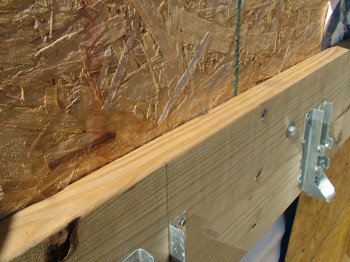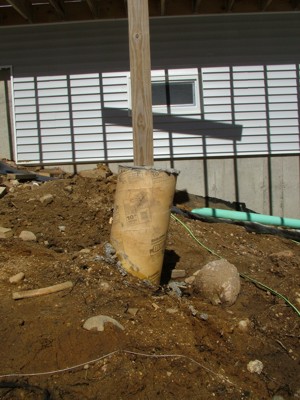What’s in This Issue?
FRIENDLY QUESTION REMINDER
FEEDBACK ABOUT LAST WEEK'S FEEDBACK
TOOL REPAIRS IN DAYS
INSPIRATION IN TWELVE SECONDS
GREAT CINCINNATI MASON AND HVAC MAN - CRAFTSMEN/WOMEN IN YOUR CITY!
COVERING A BRICK FIREPLACE
SAVE WATER NOW
WINTER IN NEW HAMPSHIRE
INSURANCE TIP - AVOID ARGUMENTS
LATEST COLUMNS
Friendly Question Reminder!
If you have a question for me, don't hit the Reply button just yet. Go immediately to my web site and type in the keywords about your problem into my Search engine. The search box is at the top of every page of my web site. You could have your answer in seconds if you do this! Please keep in mind the ads you see at my web site often are the solutions to your problems. The exact products and services you need are right in front of you, and you might be ignoring them. Always scan the ads to see if they have what you need.
Feedback about Last Week's Feedback
If you're a writer, you'll appreciate this. Fantastic writers rarely leave out a fact, thought or connector as the story line progresses. I don't consider myself close to being a superb writer as I constantly seem to leave out important parts to stories. It happened to me in the last newsletter.
Last week, if you remember, I talked about a few complainers who didn't appreciate the personal comments I try to include each week. What I failed to say was that I had absolutely no intention of changing the style of my newsletters. If you emailed me telling me to ignore the whiners, you realize from my response to you that I didn't let the complainers bother me at all.
In fact, it happened again! I had another subscriber email me this week after reading the Feedback section and he said, ".....I like your web site despite the sappy personal life experiences you foist on us. That seems to support your ego." I told this polite man - and I'm serious - that the sap is really going to start running in all future newsletters, just like the maple tree sap is now running up here in New Hampshire.
The bottom line is if you like the style of my newsletter, it's not going to change. And as for my ego, taking the time to produce this newsletter seems to wear it down, not inflate it! Oh well, this is yet another example that it's humanly impossible to satisfy everyone.
Tool Repairs in Days
Spring may have already sprung where you live. You'll soon be trying to do things and perhaps a power tool will not work, not start, or broke. In the past, it was a pain to try to discover a place to get them repaired quickly and correctly. What if I told you that you can now drop off your tools at one of the 1,700+ locations of a major big box store? Surely that should interest you! You can take your walk-behind lawn mower, riding mowers, pressure washers, gas trimmers, tillers, drills, saws, and many more tools. You can do it today! Here is where you need to go.
Inspiration in Twelve Seconds
It's pretty easy to get depressed in these challenging times. The economic news, job layoffs, stories of greed, etc. all can weigh down on you. I have two great friends, Audri and Jim Lanford, that have a great short - and free - email newsletter like mine that I highly recommend you subscribe to.
 I have a gorgeous ATTITUDE pin on top of my monitor that inspires me each day as I get started. Audri and Jim's inspirational-quote ezine is a wonderful way to start each day if you don't have a pin like mine.
I have a gorgeous ATTITUDE pin on top of my monitor that inspires me each day as I get started. Audri and Jim's inspirational-quote ezine is a wonderful way to start each day if you don't have a pin like mine.
Each issue of their personal newsletter contains:
- a hand-picked inspiring - and sometimes funny - quote
- an entertaining fact about today
- an interesting, helpful article to check out
It takes 12 seconds a day to read the email. Not a bad way to jump start your day!
Go subscribe now. Audri and Jim have a strict privacy policy like mine. Your email address is safe with them.
Great Cincinnati Mason and HVAC Man - Craftsmen/women in Your City!
Today I had the pleasure to talk on the phone with a good friend of mine. His name is John Hoeh (pronounced "hay"). John used to do all sorts of masonry work for me when I was still building. He did a magnificent flagstone patio, countless brick jobs on both room additions and custom homes, concrete-block foundations, gorgeous brick chimneys - including one of mine we 'moved' five feet, wood-burning fireplaces with REAL fire-clay joints, etc. John is an amazing craftsman. I told him that even though this newsletter goes to subscribers all over the world, you might be interested to know that real craftsmen and women still exist. If you live in Cincinnati and need a fantastic mason, call John. 513-505-8969
Add to that my best friend Richard Anderson. Richard has forgotten more about heating and air conditioning than I'll ever know. Much of what I know about the topic I've discovered talking with Richard. He and I go back nearly 25 years. One of the things I respect most about John and Richard is that they refuse to cut corners. If they can't do the job right, then they won't do it. If you want a furnace or an air conditioner to really keep you comfortable, then call Richard. 513-367-0229
I can hear you now. "Tim, I don't live in Cincinnati! How can I discover the pro in my city or town?" Great question! I have sweet checklists I've developed to help you locate the pro in your area. The best part of my checklists is that each one contains four secret videos. In the videos, I take you in my car on a real journey to show you EXACTLY how I would find a pro in your city if I came for a visit to your home. Professionals and craftsmen are in your town and city. You just have to know WHERE to go to find them, and you have to know the secret questions to ask. I show you how. Go here to get the checklist you need:
Covering a Brick Fireplace
Bridgett from Lubbock, TX emailed me asking, "We have a floor-to-ceiling fireplace, the brick has been painted. I would like to update the look. Is it possible to apply drywall mud over the painted brick in several coats and be successful?"
Well Bridgett, I would say no. Drywall mud contains adhesives that are meant to adhere to new drywall paper. I would consider installing some tile or stone surrounding the firebox to meet the current code clearances. Then you can nail furring strips to the brick and cover those with drywall to get that smooth finish you're seeking.
I'm sure there are other ways to get the smooth finish, but keep in mind all building codes and the fire danger. Don't install things that can burn immediately adjacent to the firebox.
Save Water Now - It's Very Important
If you live in California, I don't have to tell you about your water crisis. It's bad, and probably going to get a lot worse. Two or three years ago, the Southeast was in the grip of an exceptional drought. Severe drought is hitting the hill country of Texas now.
The point is clean, potable water is a valuable resource, and most of us take it for granted. Let's start getting serious about conserving water. One way you can start is by going to Save Water America.
This web site has been built by the Kohler company to help educate you about water shortages that are looming just around the corner for many here in the USA.
I urge you to visit this site for a number of reasons. You'll discover shocking facts. Did you know well over a billion gallons of drinking water are wasted here in the USA each day by wasteful toilets? Did you know that water shortages are looming in over 30 states?
If you take a quick quiz at the web site, you'll help Habitat for Humanity. Kohler has agreed to give them $1 for each quiz that's completed up to a grand total of one million dollars. If you take the quiz, it also counts in a competition among the states. So I NEED all who live in New Hampshire to take the quiz. Please! We can have some fun here.
It's a good cause, and you're going to have a new appreciation for the water that flows from your faucets. Visit Save Water America now.
Winter in New Hampshire
If you're a new subscriber, I have to tell you that I'm a new resident here in central New Hampshire. I survived my first winter! It was magnificent actually. I've never in my life seen such white snow for months on end. Each day it was like waking up to a Norman Rockwell winter painting - especially after a snowstorm when the evergreens were drooping with snow on them. Breathtaking is all I can say.
I live on the western shore of Lake Winnisquam. I call it Loch Winnisquam, and my daughter Meghan calls me the Laird of the Loch. It's a private joke. Last week, Russell, a subscriber from Australia, emailed me telling me he had never seen a frozen lake. A few other subscribers have emailed me asking me to take some winter photos. Well, I did it. It was a gorgeous day here, and I wanted to get the photos before the snow and ice disappears. Warmer days are here, and the snow and ice will soon be gone.
I also went out onto the ice in front of my house and taped two videos. I have this enormous phobia about falling through ice. It happened up here last week to two people I know. Fortunately both survived! The ice thickness immediately in front of my house is over 15-inches thick as of March 13, 2009. Wow! A Minnesota website I visited said that's thick enough to support a large pickup truck. No worries, I'm not driving mine onto the ice!
At night and during the day, the ice on the lake makes these deep bass sounds. It's eerie to put it mildly. The sounds are so deep, they easily vibrate the glass in the doors in my bedroom. I can hear the reverberating sounds through the night. I wish I could record it for you. Here are my late-winter photos.
Insurance Tip - Avoid Arguments
Two days ago, I picked up from a local framing shop a very handsome topographic map of the Central Lakes Region here in New Hampshire. The map only cost $20, but the cost of the matting, frame, special conservation glass, backing etc. took my breath away. Oh well, it's part of my own little stimulus plan I have in place in an effort to pump money into the local economy here in Meredith, NH.
If you look at this framed map, you might think I bought it at a discount store for 15% of what I paid. You can easily get a cheaper frame, no matting or double matting, no special glass, etc. Imagine if you had to prove to some number cruncher what you really had.
I made sure I left the framing store with a DETAILED receipt showing why it cost what it did, and I've taken a close-up photo of the framed map for my records. Why? Because if I ever have a catastrophic loss here at my house and the map is consumed by fire or sucked up into the sky by a tornado, I'll not get into an argument with the insurance adjuster. All of this data is digitized - I scanned the receipt and have a digital copy of the photo - and the data is stored off site.
Rest assured there are UNWRITTEN directives happening at many insurance companies now. The stock market losses have hurt the insurance industry just like you and me. Profits may be down at many companies. Pressure from upper management MAY be applied to adjusters to clamp down HARD on claims. It'll be your word against the written words in your policy. If you can't PROVE exactly what you had in your home, then be prepared for an argument - one I GUARANTEE you'll lose.
So what can you do if you have things from years ago and the receipts are gone? You start taking THOUSANDS of photos. You take wide shots showing each room and what's in it, and then you take close-up photos of each item. Take photos of labels or tags that show the model number. Hire one of your kids or a relative to do this for you. Jobs for them may be hard to find this summer. Remember, you have to take photos of everything you own.
You want there to be NO room for an argument. Burn multiple CDs of all the images and send a set to your insurance company or your agent. Be sure you send it certified mail with a return receipt so you can prove they got it. Keep a set of the CDs offsite at some safe location.
As you continue to buy things, SAVE the actual receipts, scan them if possible and take the photos. Yes, this is a huge time issue, but if you have a huge loss, you stand the chance to lose tens, even hundreds, of thousands of dollars if you can't prove you had the items. This is the first in a series of insurance tips. The target has been acquired.
Latest Columns
Do you need to do your own home remodeling and repair in these tough times?
Which national window company makes the most windows each day? My best friend Richard knows. He has the same name!
Discover the room in your home where you're missing an important cabinet!
If you grew up on a farm in a place where it got cold each winter, it's possible each spring you had to do remove something from the fields.
Screened porches are really popular. You may need a tip or two to save time and money.
With money tight, I may be able to help you with a roof repair.
You have to see the unique hardwood floor in my New Hampshire house. You'll never guess the species looking at the photo.
Click here to read past copies of my newsletters.
AsktheBuilder.com



 I have a gorgeous ATTITUDE pin on top of my monitor that inspires me each day as I get started. Audri and Jim's inspirational-quote ezine is a wonderful way to start each day if you don't have a pin like mine.
I have a gorgeous ATTITUDE pin on top of my monitor that inspires me each day as I get started. Audri and Jim's inspirational-quote ezine is a wonderful way to start each day if you don't have a pin like mine.

